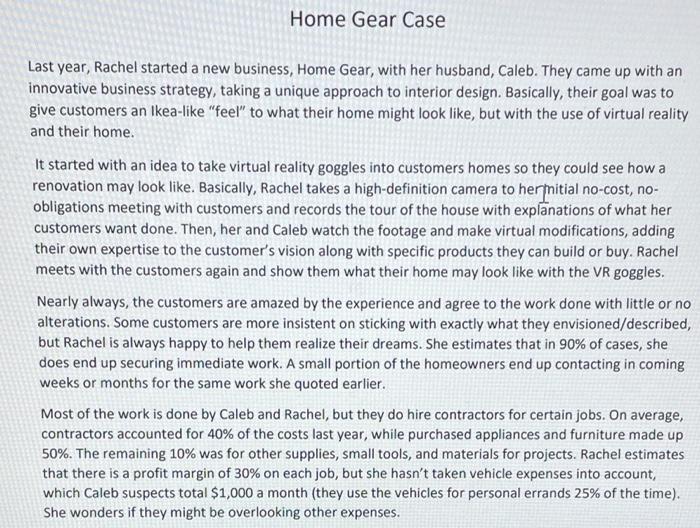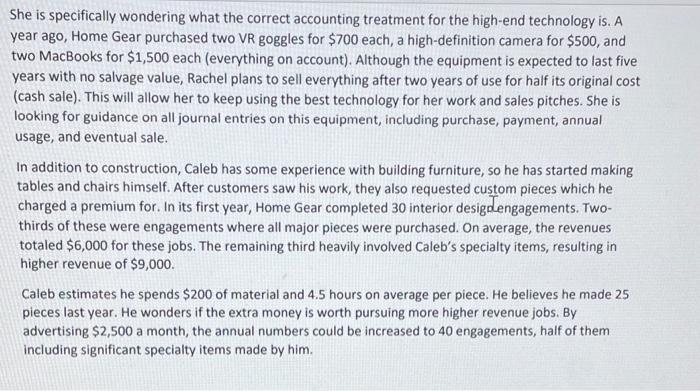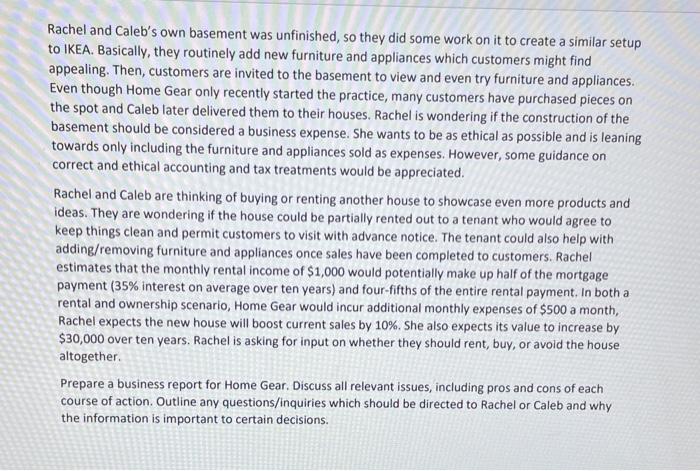Home Gear Case Last year, Rachel started a new business, Home Gear, with her husband, Caleb. They came up with an innovative business strategy, taking a unique approach to interior design. Basically, their goal was to give customers an Ikea-like "feel" to what their home might look like, but with the use of virtual reality and their home. It started with an idea to take virtual reality goggles into customers homes so they could see how a renovation may look like. Basically, Rachel takes a high-definition camera to hermitial no-cost, no- obligations meeting with customers and records the tour of the house with explanations of what her customers want done. Then, her and Caleb watch the footage and make virtual modifications, adding their own expertise to the customer's vision along with specific products they can build or buy. Rachel meets with the customers again and show them what their home may look like with the VR goggles. Nearly always, the customers are amazed by the experience and agree to the work done with little or no alterations. Some customers are more insistent on sticking with exactly what they envisioned/described, but Rachel is always happy to help them realize their dreams. She estimates that in 90% of cases, she does end up securing immediate work. A small portion of the homeowners end up contacting in coming weeks or months for the same work she quoted earlier. Most of the work is done by Caleb and Rachel, but they do hire contractors for certain jobs. On average, contractors accounted for 40% of the costs last year, while purchased appliances and furniture made up 50%. The remaining 10% was for other supplies, small tools, and materials for projects. Rachel estimates that there is a profit margin of 30% on each job, but she hasn't taken vehicle expenses into account, which Caleb suspects total $1,000 a month (they use the vehicles for personal errands 25% of the time). She wonders if they might be overlooking other expenses. She is specifically wondering what the correct accounting treatment for the high-end technology is. A year ago, Home Gear purchased two VR goggles for $700 each, a high-definition camera for $500, and two MacBooks for $1,500 each (everything on account). Although the equipment is expected to last five years with no salvage value, Rachel plans to sell everything after two years of use for half its original cost (cash sale). This will allow her to keep using the best technology for her work and sales pitches. She is looking for guidance on all journal entries on this equipment, including purchase, payment, annual usage, and eventual sale. In addition to construction, Caleb has some experience with building furniture, so he has started making tables and chairs himself. After customers saw his work, they also requested custom pieces which he charged a premium for. In its first year, Home Gear completed 30 interior desigdengagements. Two- thirds of these were engagements where all major pieces were purchased. On average, the revenues totaled $6,000 for these jobs. The remaining third heavily involved Caleb's specialty items, resulting in higher revenue of $9,000. Caleb estimates he spends $200 of material and 4.5 hours on average per piece. He believes he made 25 pieces last year. He wonders if the extra money is worth pursuing more higher revenue jobs. By advertising $2,500 a month, the annual numbers could be increased to 40 engagements, half of them including significant specialty items made by him. Rachel and Caleb's own basement was unfinished, so they did some work on it to create a similar setup to IKEA. Basically, they routinely add new furniture and appliances which customers might find appealing. Then, customers are invited to the basement to view and even try furniture and appliances. Even though Home Gear only recently started the practice, many customers have purchased pieces on the spot and Caleb later delivered them to their houses. Rachel is wondering if the construction of the basement should be considered a business expense. She wants to be as ethical as possible and is leaning towards only including the furniture and appliances sold as expenses. However, some guidance on correct and ethical accounting and tax treatments would be appreciated. Rachel and Caleb are thinking of buying or renting another house to showcase even more products and ideas. They are wondering if the house could be partially rented out to a tenant who would agree to keep things clean and permit customers to visit with advance notice. The tenant could also help with adding/removing furniture and appliances once sales have been completed to customers. Rachel estimates that the monthly rental income of $1,000 would potentially make up half of the mortgage payment (35% interest on average over ten years) and four-fifths of the entire rental payment. In both a rental and ownership scenario, Home Gear would incur additional monthly expenses of $500 a month, Rachel expects the new house will boost current sales by 10%. She also expects its value to increase by $30,000 over ten years, Rachel is asking for input on whether they should rent, buy, or avoid the house altogether Prepare a business report for Home Gear. Discuss all relevant issues, including pros and cons of each course of action. Outline any questions/inquiries which should be directed to Rachelor Caleb and why the information is important to certain decisions









